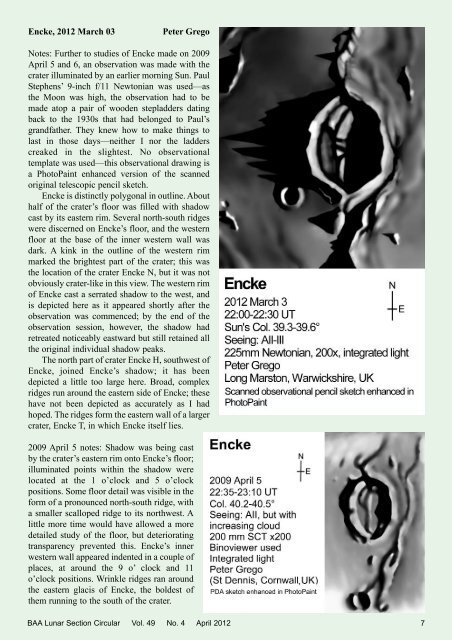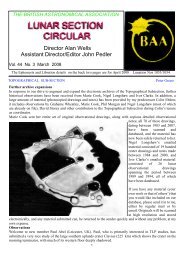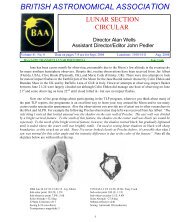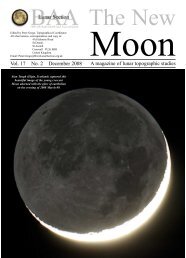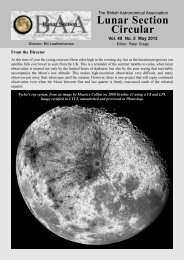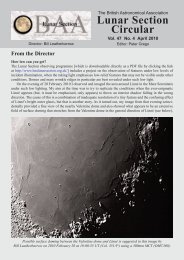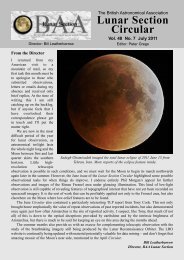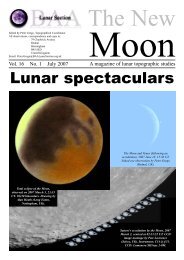Vol 49, No 4, April 2012 - BAA Lunar Section
Vol 49, No 4, April 2012 - BAA Lunar Section
Vol 49, No 4, April 2012 - BAA Lunar Section
Create successful ePaper yourself
Turn your PDF publications into a flip-book with our unique Google optimized e-Paper software.
Encke, <strong>2012</strong> March 03<br />
Peter Grego<br />
<strong>No</strong>tes: Further to studies of Encke made on 2009<br />
<strong>April</strong> 5 and 6, an observation was made with the<br />
crater illuminated by an earlier morning Sun. Paul<br />
Stephens’ 9-inch f/11 Newtonian was used—as<br />
the Moon was high, the observation had to be<br />
made atop a pair of wooden stepladders dating<br />
back to the 1930s that had belonged to Paul’s<br />
grandfather. They knew how to make things to<br />
last in those days—neither I nor the ladders<br />
creaked in the slightest. <strong>No</strong> observational<br />
template was used—this observational drawing is<br />
a PhotoPaint enhanced version of the scanned<br />
original telescopic pencil sketch.<br />
Encke is distinctly polygonal in outline. About<br />
half of the crater’s floor was filled with shadow<br />
cast by its eastern rim. Several north-south ridges<br />
were discerned on Encke’s floor, and the western<br />
floor at the base of the inner western wall was<br />
dark. A kink in the outline of the western rim<br />
marked the brightest part of the crater; this was<br />
the location of the crater Encke N, but it was not<br />
obviously crater-like in this view. The western rim<br />
of Encke cast a serrated shadow to the west, and<br />
is depicted here as it appeared shortly after the<br />
observation was commenced; by the end of the<br />
observation session, however, the shadow had<br />
retreated noticeably eastward but still retained all<br />
the original individual shadow peaks.<br />
The north part of crater Encke H, southwest of<br />
Encke, joined Encke’s shadow; it has been<br />
depicted a little too large here. Broad, complex<br />
ridges run around the eastern side of Encke; these<br />
have not been depicted as accurately as I had<br />
hoped. The ridges form the eastern wall of a larger<br />
crater, Encke T, in which Encke itself lies.<br />
2009 <strong>April</strong> 5 notes: Shadow was being cast<br />
by the crater’s eastern rim onto Encke’s floor;<br />
illuminated points within the shadow were<br />
located at the 1 o’clock and 5 o’clock<br />
positions. Some floor detail was visible in the<br />
form of a pronounced north-south ridge, with<br />
a smaller scalloped ridge to its northwest. A<br />
little more time would have allowed a more<br />
detailed study of the floor, but deteriorating<br />
transparency prevented this. Encke’s inner<br />
western wall appeared indented in a couple of<br />
places, at around the 9 o’ clock and 11<br />
o’clock positions. Wrinkle ridges ran around<br />
the eastern glacis of Encke, the boldest of<br />
them running to the south of the crater.<br />
<strong>BAA</strong> <strong>Lunar</strong> <strong>Section</strong> Circular <strong>Vol</strong>. <strong>49</strong> <strong>No</strong>. 4 <strong>April</strong> <strong>2012</strong><br />
7


